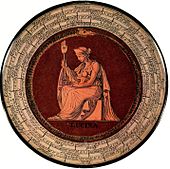Johann Heinrich Stobwasser
Johann Heinrich Stobwasser (born November 16, 1740 in Lobenstein , † August 31, 1829 in Braunschweig ) was a German lacquerware manufacturer .
life and work
The son of the trained glazier and small goods dealer Georg Siegmund Eustachius Stobwasser and his wife Christine Elisabeth, née. Fichte, from Lobenstein in the Vogtland region, accompanied his father on various business trips at the age of 15. In the absence of his father, Johann Heinrich ran the business himself. After lengthy attempts he had succeeded in producing his own durable amber lacquer of the highest quality, he founded a factory for lacquer objects in his local Lobenstein. There he produced, among other things, lacquered walking sticks, mugs and snuff boxes . Due to economic problems, however, the company soon had to close again. In August 1763, the Stobwasser family of six responded to a call from Duke Karl I of Brunswick to settle in his duchy. Charles I offered highly qualified craftsmen and artists numerous perks when they settled in the duchy in order to stimulate the local economy.
Foundation of the Stobwasserschen Manufactory in Braunschweig
→ Main article: Stobwasser (manufactory)

Shortly after the company was founded, everyday items were initially produced, soon followed by handicrafts and finally - because of the great success and outstanding quality - luxury goods . For painting in particular, he employed well-known artists such as B. Pascha Johann Friedrich Weitsch and his son Friedrich Georg Weitsch , but also Christian Tunica , Hans Heinrich Jürgen Brandes , Julius Carl Hermann Schröder , Heinrich Christian Brüning or the Icelandic Thorstein Elias Hjaltelin .
The reputation of lacquerware, soon known as “Stobwasser-Arbeit”, spread quickly across the borders of the Duchy throughout Europe, so that one of Johann Heinrich's sisters, Luise Dorothee Guérin , together with her husband Jean, a former Braunschweig musketeer and later employee , in 1772 was able to open a branch in his brother-in-law's company in Berlin .
In 1774 Johann Heinrich married Sophie Elisabeth Gersting († 1809) from Hanover , daughter of the local carpenter. The marriage produced eight children, five of whom died young. Son Christian Heinrich took over the Brunswick company in 1808. In 1812 Johann Heinrich Stobwasser married Katharine Dorothee Scheurer († 1825), widowed Röntgen, the mother of one of his sons-in-law.
Johann Heinrich Stobwasser's life was described in 1830 by his son Christian Heinrich in the biography “The strangest incidents from the life story of Johann Heinrich Stobwasser. For the memory of his friends and for the good of the sick = coffers of the Stobwasser factory ” . He was buried in the Michaelisfriedhof in Braunschweig, where his grandson G. Stobwasser had a bronze bust erected for him in 1882.
literature
- Camerer, Garzmann, Schuegraf, Pingel: Braunschweiger Stadtlexikon , Braunschweig 1992 Braunschweig 1992, ISBN 3-926701-14-5
- Detlev Richter (ed.): Stobwasser - lacquer art from Braunschweig & Berlin , 2 volumes, Prestel-Verlag 2005, ISBN 3-7913-3439-5
- Horst-Rüdiger Jarck, Günter Scheel (Ed.): Braunschweigisches Biographisches Lexikon. 19th and 20th centuries , Hannover 1996, ISBN 3-7752-5838-8
- Paul Zimmermann : Stobwasser, Johann Heinrich . In: Allgemeine Deutsche Biographie (ADB). Volume 36, Duncker & Humblot, Leipzig 1893, p. 275 f.
Web links
- Christian Heinrich Stobwasser: The strangest incidents from the life story of Johann Heinrich Stobwasser. In memory of his friends, and for the best of the sick = casse of the Stobwasserschen Fabrik (digital copy at the Digital Library Braunschweig)
Individual evidence
- ↑ a b c Paul Zimmermann: Entry in the General German Biography of Johann Heinrich Stobwasser
- ↑ Leuschner, Kaufhold, Märtl (ed.): The economic and social history of the Braunschweigisches Land from the Middle Ages to the present , Volume 2: Early modern times , p. 648
- ↑ Leuschner, Kaufhold, Märtl (ed.): The economic and social history of the Braunschweigisches Land from the Middle Ages to the present , Volume 2: Early Modern Age , p. 609
- ↑ Leuschner, Kaufhold, Märtl (ed.): The economic and social history of the Braunschweigisches Land from the Middle Ages to the present , Volume 2: Early modern times , p. 654
- ↑ Ferdinand Spehr: Hialtalin, Dorstein Illia . In: Allgemeine Deutsche Biographie (ADB). Volume 12, Duncker & Humblot, Leipzig 1880, p. 383 f.
- ↑ Jürgen Hodemacher: Braunschweigs Straßen - their names and their stories, Volume 3: Outside the Stadtring , Braunschweig 2001, p. 258f
- ^ Digitized at the Digital Library Braunschweig
| personal data | |
|---|---|
| SURNAME | Stobwasser, Johann Heinrich |
| BRIEF DESCRIPTION | German lacquerware manufacturer |
| DATE OF BIRTH | November 16, 1740 |
| PLACE OF BIRTH | Praise stone |
| DATE OF DEATH | August 31, 1829 |
| Place of death | Braunschweig |

